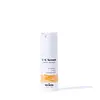What's inside
What's inside
 Key Ingredients
Key Ingredients

 Benefits
Benefits

 Concerns
Concerns

 Ingredients Side-by-side
Ingredients Side-by-side

Ascorbic Acid
AntioxidantHippophae Rhamnoides Fruit Extract
Skin ConditioningDipropylene Glycol
HumectantPropanediol
SolventMethylpropanediol
SolventSodium PCA
HumectantC12-14 Pareth-12
EmulsifyingPortulaca Oleracea Extract
Skin ConditioningGlycyrrhiza Uralensis Extract
EmollientLavandula Angustifolia Oil
MaskingCitrus Aurantium Bergamia Fruit Oil
MaskingRosmarinus Officinalis Leaf Oil
MaskingHydrogenated Lecithin
EmulsifyingSodium Hyaluronate
HumectantChamomilla Recutita Flower Oil
MaskingAnthemis Nobilis Flower Oil
MaskingWater
Skin ConditioningAmmonium Acryloyldimethyltaurate/Vp Copolymer
Panthenol
Skin ConditioningGlycerin
HumectantCitric Acid
BufferingAllantoin
Skin ConditioningTocopherol
AntioxidantTranexamic Acid
AstringentHydroxydecyl Ubiquinone
AntioxidantCaprylic/Capric Triglyceride
MaskingDisodium EDTA
Sodium Citrate
BufferingFullerenes
AntimicrobialHydroxypropyl Cyclodextrin
MaskingCeramide NP
Skin ConditioningGlutathione
Phytosteryl/Octyldodecyl Lauroyl Glutamate
Skin ConditioningHydroxyacetophenone
AntioxidantEthylhexylglycerin
Skin Conditioning1,2-Hexanediol
Skin ConditioningAscorbic Acid, Hippophae Rhamnoides Fruit Extract, Dipropylene Glycol, Propanediol, Methylpropanediol, Sodium PCA, C12-14 Pareth-12, Portulaca Oleracea Extract, Glycyrrhiza Uralensis Extract, Lavandula Angustifolia Oil, Citrus Aurantium Bergamia Fruit Oil, Rosmarinus Officinalis Leaf Oil, Hydrogenated Lecithin, Sodium Hyaluronate, Chamomilla Recutita Flower Oil, Anthemis Nobilis Flower Oil, Water, Ammonium Acryloyldimethyltaurate/Vp Copolymer, Panthenol, Glycerin, Citric Acid, Allantoin, Tocopherol, Tranexamic Acid, Hydroxydecyl Ubiquinone, Caprylic/Capric Triglyceride, Disodium EDTA, Sodium Citrate, Fullerenes, Hydroxypropyl Cyclodextrin, Ceramide NP, Glutathione, Phytosteryl/Octyldodecyl Lauroyl Glutamate, Hydroxyacetophenone, Ethylhexylglycerin, 1,2-Hexanediol
 Reviews
Reviews

Ingredients Explained
These ingredients are found in both products.
Ingredients higher up in an ingredient list are typically present in a larger amount.
Ascorbic Acid is is pure Vitamin C. This form makes up the largest amount of vitamin C found naturally in our skin.
Not only is vitamin C great for your overall health and immune system, it also has plenty of benefits on your skin.
Vitamin C is best used for brightening skin. It improves dark spots, acne scars, and hyperpigmentation. This is because it blocks the process of skin darkening when exposed to UV.
Remember: Vitamin C should not replace sunscreen!
Your skin uses vitamin C to build collagen. Collagen is one key component in having a strong skin barrier and plump skin. Vitamin C also plays a role in regulating collagen, thus making it effective in improving wrinkles and fine lines.
Ascorbic acid shows potent antioxidant activity. As an antioxidant, it helps fight free-radicals. Free-radicals are molecules that may damage your skin cells. These antioxidants also protect skin against UV damage.
The best formulations include Vitamin E and/or ferulic acid. These two ingredients help stabilize and provide a boost in the benefits of ascorbic acid. This is because ascorbic acid becomes unstable when exposed to UV and air. In fact, you can tell your ascorbic acid has oxidized when it turns an orange-yellow color.
Ascorbic acid is generally compatible with other ingredients. However, using ascorbic acid with other active ingredients might cause irritation. Two ingredients: copper ions and benzoyl peroxide, will inactivate ascorbic acid completely.
Read more about other types of Vitamin C:
Foods rich with vitamin C include oranges, strawberries, broccoli, bell peppers, and more. When consuming Vitamin C, your skin receives a portion of the nutrients.
Learn more about Ascorbic AcidTocopherol (also known as Vitamin E) is a common antioxidant used to help protect the skin from free-radicals and strengthen the skin barrier. It's also fat soluble - this means our skin is great at absorbing it.
Vitamin E also helps keep your natural skin lipids healthy. Your lipid skin barrier naturally consists of lipids, ceramides, and fatty acids. Vitamin E offers extra protection for your skin’s lipid barrier, keeping your skin healthy and nourished.
Another benefit is a bit of UV protection. Vitamin E helps reduce the damage caused by UVB rays. (It should not replace your sunscreen). Combining it with Vitamin C can decrease sunburned cells and hyperpigmentation after UV exposure.
You might have noticed Vitamin E + C often paired together. This is because it is great at stabilizing Vitamin C. Using the two together helps increase the effectiveness of both ingredients.
There are often claims that Vitamin E can reduce/prevent scarring, but these claims haven't been confirmed by scientific research.
Learn more about Tocopherol